ASUS P8Z68-V PRO Review: Our First Z68 Motherboard
by Ian Cutress on May 11, 2011 3:13 AM EST- Posted in
- Motherboards
- Asus
- Z68
3D Movement Algorithm Test
The first benchmark ran is actually one I have written. My full time job involves computational chemistry, so this first benchmark uses various algorithms for three-dimensional simulation and movement of independent particles. The algorithms both employ uniform random number generation or normal distribution random number generation, and vary in various amounts of trigonometric operations, conditional statements, generation and rejection, fused operations, etc. The benchmark runs through six algorithms for a specified number of particles and steps, and calculates the speed of each algorithm, then sums them all for a final score. This is an example of a real world situation that a computational scientist may find themselves in, rather than a pure synthetic benchmark. The benchmark is also parallel between particles simulated, and we test the single thread performance as well as the multi-threaded performance.
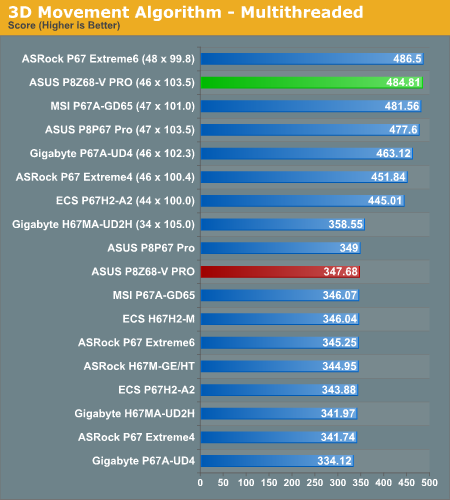
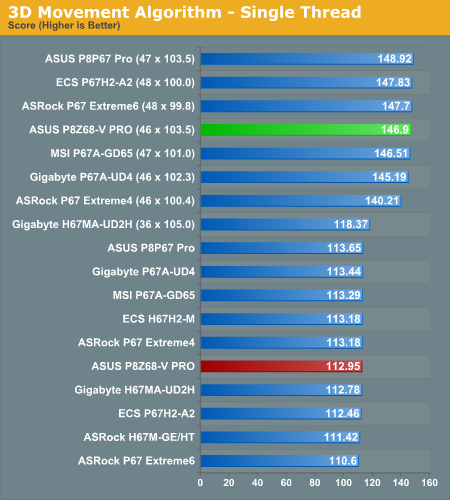
WinRAR x64 3.93
With 64-bit WinRAR, we compress the set of files used in the USB speed tests. WinRAR x64 3.93 attempts to use multithreading when possible.
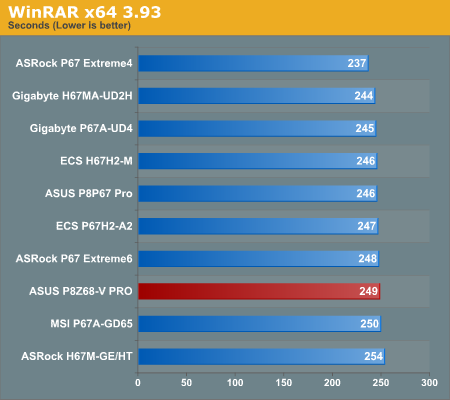
FastStone Image Viewer 4.2
FastStone Image Viewer is a free piece of software I have been using for quite a few years now. It allows quick viewing of flat images, as well as resizing, changing color depth, adding simple text or simple filters. It also has a bulk image conversion tool, which we use here. The software currently operates only in single-thread mode, which should change in later versions of the software. For this test, we convert a series of 170 files, of various resolutions, dimensions and types (of a total size of 163MB), all to the .gif format of 640x480 dimensions.
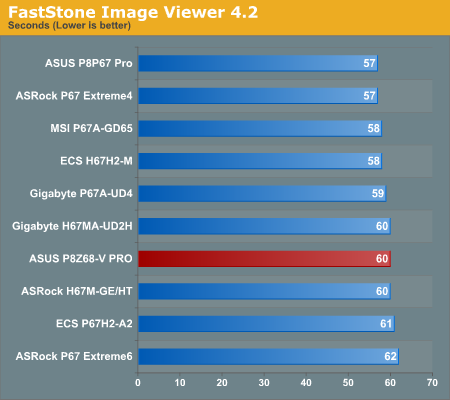
Sorenson Squeeze 6.0
Sorenson Squeeze is a professional video encoder, complete with a vast array of options. For this test, we convert 32 HD videos, each a minute long and approximately 42 MB in size, to WMV 512KBps format. Squeeze can encode multiple videos at once, one for each thread.
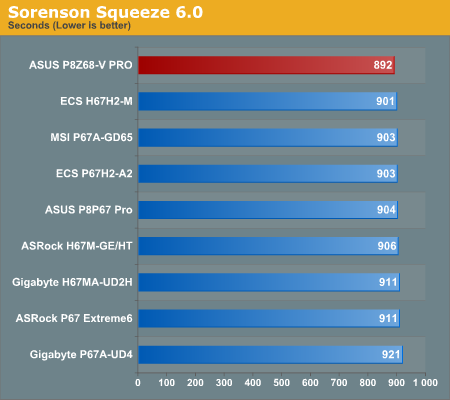
The ASUS does relatively well in our Computation bench suite, with an excellent Squeeze score. It's not the fastest board so far, but the difference between the slowest and fastest board in each test is only 3-9%, so for stock performance it's not something generally noticeable in day to day use.










95 Comments
View All Comments
L. - Thursday, May 12, 2011 - link
IGP Intel = Ouch.I believe that if you need multiple displays you'll be far better off waiting for amd llano or the next gen of intel fail-gpu.
sylar365 - Wednesday, May 11, 2011 - link
Right now I am using an Asrock P67 Extreme 4, i5-2500k, OCZ Vertex 2 64GB with Windows and a couple frequently used apps and a WD 640GB Black SATA 2 for bulk storage. I only use one graphics card in the form of a GTX 560 ti and I appreciate it's performance but am in love with it's power usage. As far as I can tell it seems like upgrading to the Z68 platform would not provide much gain in gaming FPS, SSD longevity or overclocking ability. Those issues aside would I see ANY decrease in my monthly electric bill after partially using my CPU's on chip GPU? Even while assuming that I have some disposable income it still seems that jumping from P67 to Z68 would be like throwing money into the wind unless I plan on ... nope, nevermind ... even adding a second 560 ti would be faster on my current board. As far as investments go (for me anyway) making it rain at the local strip club is looking to be a more responsible path than upgrading to Z68.AnnihilatorX - Wednesday, May 11, 2011 - link
Or if you are like me who hold out onto my B2 P67 until it died 2 weeks ago and get a refund and buy Z68 :PSunsmasher - Wednesday, May 11, 2011 - link
Upgrade doesn't make sense for you because you apparently don't do much transcoding....L. - Thursday, May 12, 2011 - link
Like most people ;)Otherwise, this motherboard looks like a piece of trash for 210 bucks, very limited pciE, etc.. who would want it.
There is a fair chance you will see Z68 boards that are much more convincing.
Tylanner - Wednesday, May 11, 2011 - link
Man would I be upset if I held out for Z68 all these months.I was expecting an improvement in Multi-GPU Scaling(2-way Sli)
AnnihilatorX - Wednesday, May 11, 2011 - link
No. Z68 is still limited by number of PCI-E. The main reason is CPU really. You'd have to go for Z79 and Sandybridge-E for higher PCI-e lanes count.AnnihilatorX - Wednesday, May 11, 2011 - link
Actually disregard me, bandwidth should be sufficient for 2-way SLIrbusch - Wednesday, May 11, 2011 - link
On page two if the review it says...."here are a couple of negative points however - the iGPU frequency requires a reboot after every selection, and the changes you do make to the CPU frequency aren't written to BIOS (and thus aren't permanent) nor are they initialised on reboot, requiring a manual adjust on every boot."
Does this (the CPU bit) differ from the P8P67 PRO board? Am I understanding correctly that any CPU overclock done in windows (as opposed to UEFI) disappears every single time the machine is rebooted?
rbusch - Wednesday, May 11, 2011 - link
And forgive me if this is a obvious and stupid question but at (nearly) the same price point, would there be any advantages of choosing the P8P67 Pro over the P8Z68-V PRO?Thanks